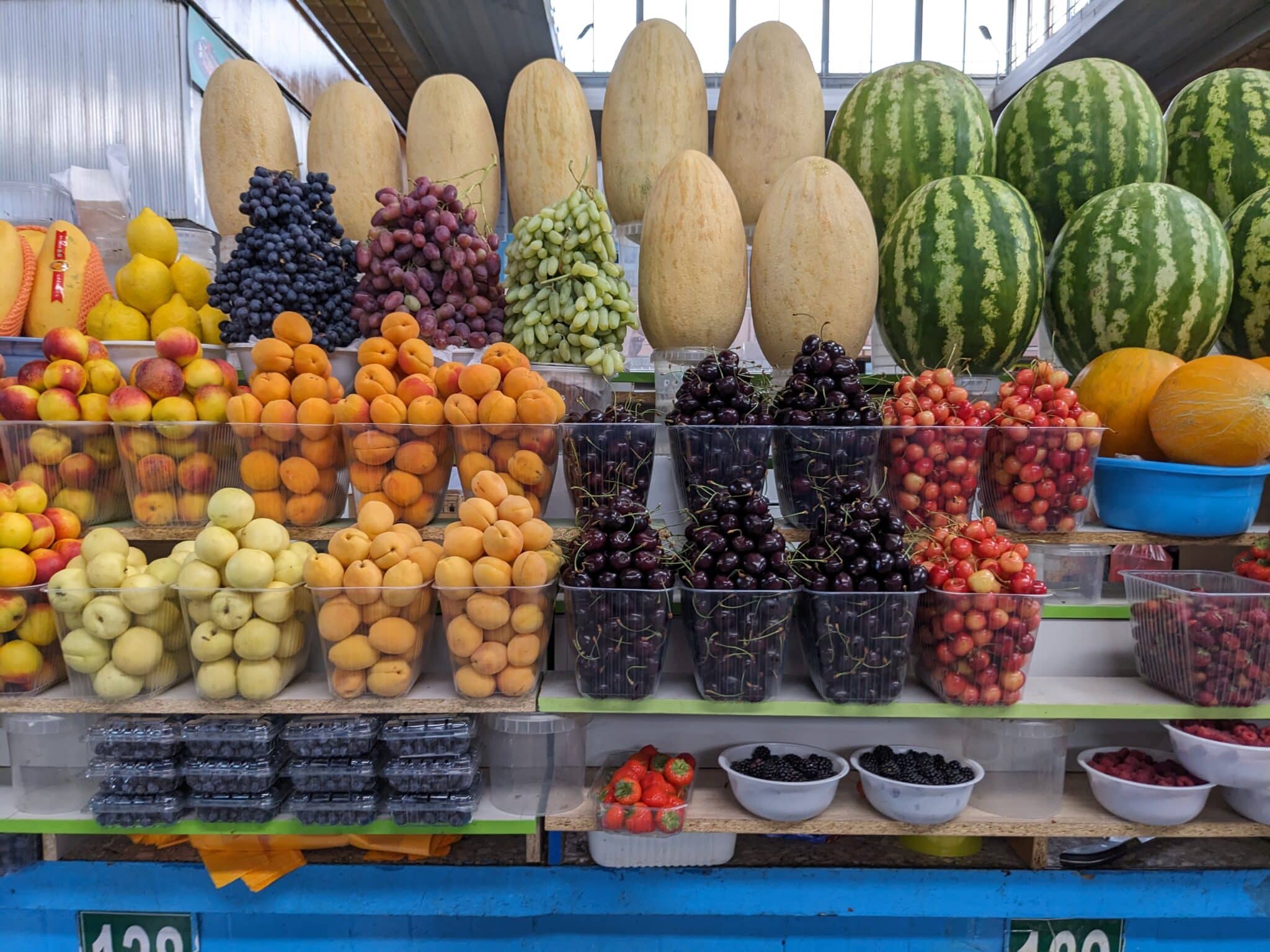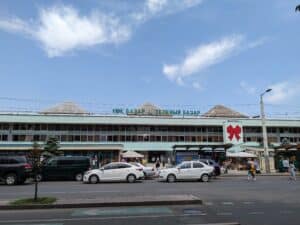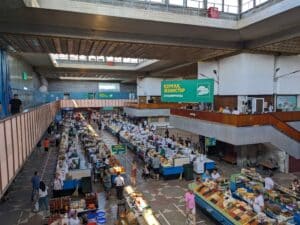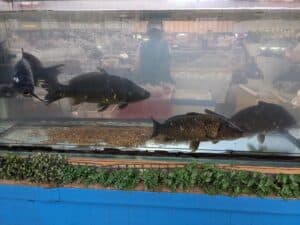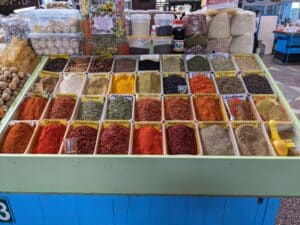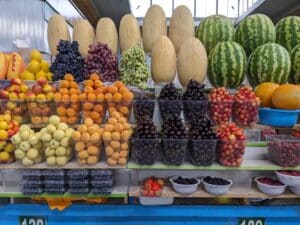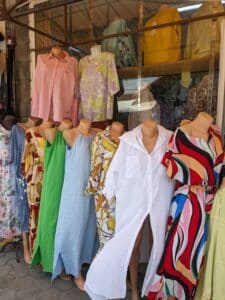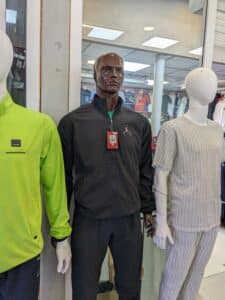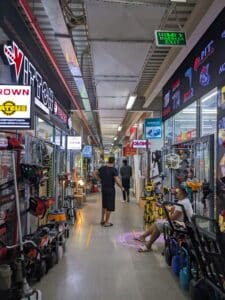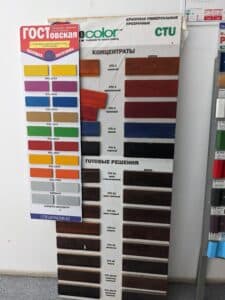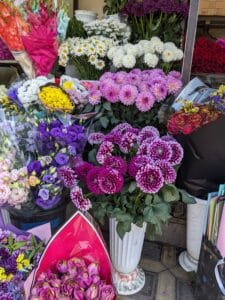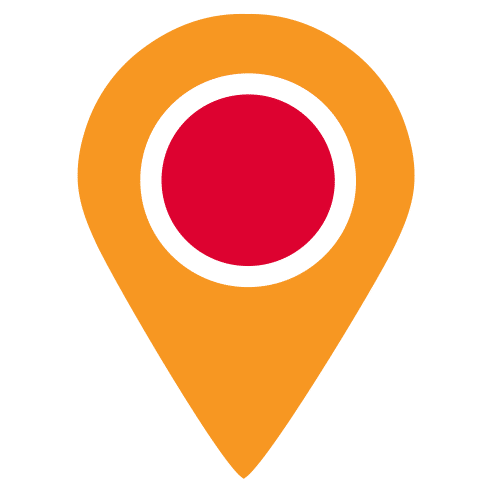The markets of Almaty are where many locals go to pick up just about anything from groceries to TV sets. These are traditional marketplaces – known usually as “базар” or sometimes called by the Russian word “рынок” – and can often feel crowded and chaotic to those used to spaciousness and organization of Western commerce.
Central Asian markets will often be crowded with open stalls with cases of fruits and vegetables lining the tables and the floor, t-shirts, hats, and pants lining the walls, and vendors walking about in front of their stalls advertising their products and beckoning you with free samples. Some may be more compartmentalized and laid back, but all will have an overarching feeling of energy. It can be a definite departure from your comfort zone, but also a great way to feel like you are experiencing local life.
All of Almaty’s bazaars are accessible by public transport or via reasonably priced cabs you can order from apps. The sellers will accept the local currency, the Kazakh tenge, but you can also pay with Kaspi, a peer-to-peer money-transfer app like Venmo that was founded in and is now just about ubiquitous throughout Kazakhstan. Some enterprising vendors might take credit and debit card payments, but you should come prepared to pay with cash or Kaspi.
Green Bazaar
The Green Bazaar (Зелёный Базар) has been a major trading center in Almaty, Kazakhstan since it opened in 1875. The Green Bazaar has long been a center of daily life in Almaty and today, its indoor and outdoor stalls sell everything from food to clothing and electronics. It’s a great place to pick up souvenirs, try some local delicacies, and generally feel like you’ve been to the “real Almaty”. The Green Bazaar provides shoppers with everything they need, and even a few things they did not know they needed!
Open from 9 to 7 every day except Monday, the Green Bazaar is located at the corners of Zenkov St and Zhibek Zholy St in the Medeu District. Raiymbek Batyr metro station is about a 20 minute walk away – but a walk that can also take you by the beautiful Almaty Central Mosque on the way. Also, right across the street from the bazaar is the Lotte Rakhat Candy Factory, a famous soviet-era factory now owned by the Korean food giant Lotte. It is always a good idea to have a snack before shopping to prevent over-shopping, and what better way to do that than in a chocolate factory?
You can also easily order a taxi on Yandex Go (a local app like Uber and Lyft) or use the public bus routes. I arrived by taxi and was immediately stunned by the sheer number of people milling about and the number of outdoor stalls next to the larger-than-life central building. From hardware to children’s toys, I could already tell that this place would be filled with all types of things, and I had yet to even step foot inside!
I spent some time walking around the stalls that lined the front of the main building, enjoying speaking with the various stall owners. While most of them only spoke Kazakh and Russian, or even just Russian, several wanted to practice their English-speaking skills with me while advertising their wares. Many people were also interested in hearing about America, and they certainly had a lot of questions! Many vendors are more than willing to haggle, so having a command of Kazakh or Russian will certainly help you save some tenge, and it is a fantastic way to practice your language skills! Otherwise, I would recommend bringing a Russian or Kazakh-speaking friend with you if you plan to do a bit of shopping here if you don’t speak one of those languages yourself.
Upon entering the main building, I was immediately hit with the overwhelming smell of fresh spices. Looking around me, I saw every type of food that I could think of being sold. From vegetables and fruit to fresh meat and live fish, there was something here for everyone. The central building is divided into sections, with signs overhead denoting their contents: meats, fruits, vegetables, plants, and dairy.
The second thing that struck me was the sheer number of people inside the building. Everywhere I looked, people were hustling from one place to another, pushing carts loaded with various things. If I stood in one place for too long, there were bound to be people squeezing past me, rushing off to their next stop. It seemed like everyone here knew exactly where everything was, and they were determined to find what they needed as quickly as possible. After spending a few minutes inside, I got used to the flow of the bodies, and I began to feel like I was fitting in with my surroundings. It was amazing to feel like I had truly stepped into another culture, embracing all types of things that would have previously lay outside of my comfort zone. It was gratifying to just walk around and feel as if I was a part of something that had been taking place for nearly 150 years. Having been there a few times now, I can say that, in my experience, the earlier in the day that you go, the less crowded the bazaar will be.
If your stomach can handle it, I highly recommend walking through the butcher area. All along the back wall of the main building, there are men and women at work, preparing and selling many diverse types of meat. As someone who grew up somewhere without many “true” butcher shops, it certainly took a second to get used to both the amount and variety of meat available for sale. For the adventurous with access to a kitchen, this is the perfect opportunity to buy some horse meat and try your hand at cooking beshbarmak, the national dish of Kazakhstan. If not, you may at least have the opportunity of seeing a whole sheep’s head up for sale (a Kazakh delicacy).
After buying a cup of kompot (a traditional fruit drink in Russia and Central Asia) from a vendor in the fruit area, I knew what was next for me: trying kumis. This traditional Kazakh drink is made from fermented mare’s milk and is often mentioned alongside shubat, a Kazakh drink made from fermented camel’s milk. After finding a vendor selling both drinks in the dairy area, I purchased a cup of kumis for 500 tenge ($1.05). While I highly recommend trying both drinks to get a taste of true Kazakh culture, I must warn you that they are not for everyone! If the taste is not for you, at least you can buy a world-famous Almaty apple from any of the fruit vendors at the Green Bazaar to help cleanse your palate. The name “Almaty” actually means “Father Apple,” and it is thought that this land is where apples originally came from. (They arrived in America only with the Spaniards in the 1500s.)
The main building also offers a pharmacy, several restaurants, and a pair of cafes. There is a place in the basement that specializes in fresh Dungan noodle dishes that is particularly recommended. There is also a coffee shop in the center on a second floor that overlooks the facility. You can pick up some Kazakh deserts on the first floor and enjoy them with a small cup of thick Turkish coffee there.
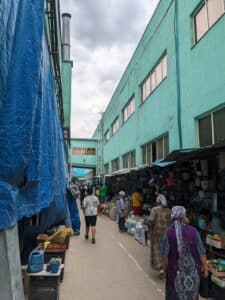
After spending time exploring the main building, you may think that you are done with the Green Bazaar. This could hardly be further from the truth! Once you pass through a set of doors on the back wall of the building, you realize that you have only seen a small portion so far. Through these doors, you can find stalls full of dress pants, soccer jerseys, shoes, hats, purses, children’s toys, used books, and so much more. It is also in this area that you will find a massive indoor home goods section, with vendors carrying pots and pans, furniture, art, and all types of technology. No matter what you are interested in, there is something here for you to buy or admire, and certainly people for you to spend time speaking with.
While walking past a stall in the home goods section, I noticed an area piled high with souvenirs. My parents collect refrigerator magnets, so I wanted to grab one to bring back home for them. After talking to the owner about her souvenir apple paperweights, genuine Russian Matryoshka dolls, and traditional Russian Orthodox women’s headdresses, I started negotiating with her over the magnets. After a quick back and forth, we settled on two smaller magnets and one large magnet for a total of 1100 tenge, or $2.31,
Happy with my purchase, I made my way back to the main building of the bazaar before leaving to check out the nearby Panifilov Park, dedicated to the remembrance of WWII and with several historical buildings within it.
Overall, the Green Bazaar serves Almaty as a massive outdoor and indoor market, where people from across Almaty shop for groceries, buy new clothes and even purchase gifts for friends and family. One can easily spend several hours here without even realizing it, as there is always something new to look at or someone new to speak with. If you are looking to buy just about anything in Almaty, the Green Bazaar should be your first stop!
Orbita Market and Shopping Mall
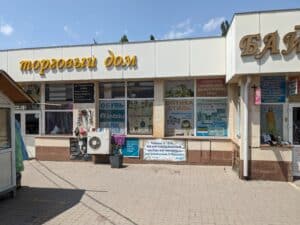
Orbita (рынок “Орбита”) is smaller and much more laid-back than the Green Bazaar, but is still fairly large and has its busy moments. The food section is nowhere near as extensive, but the clothing section is quite large, and one can find considerable traditional Kazakh and Russian clothing here, if that’s something you are looking for.
Located on the southern side of Almaty in an area dominated by Soviet-era residential buildings, the neighborhood around the Orbita Market is already much less busy than the center of the city. There are still plenty of food options nearby, including Gippo, a local burger chain. Orbita is open from 9 to 7 every day.
Where the Green Bazaar takes up an entire block, Orbita is not much larger than the modern supermarket next door to it. Orbita is organized more like an outdoor mall, with a clearer separation between each shop. There were also more indoor shopping areas here, making Orbita a good option for shopping on a sweltering Kazakh day.
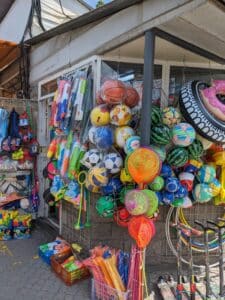
Prices are much more clearly labeled here, and most things are cheaper here than at the Green Bazaar. Even with the labeled prices, most shop owners are happy to haggle, especially if you start your conversation by complementing their goods or if you will make several purchases with them. However, whereas the Green Bazaar had had some sellers that could speak a little English, speaking Russian or Kazakh is necessary at Orbita.
Between the buildings that comprised the Orbita Market, stands were selling fresh apples, cherries, cucumbers, beets, and many other types of produce. While there were no butcher areas, there were two Belarusian markets that sold meats and cheeses. Besides a few spice sellers and a handful of tiny restaurants, this was all Orbita had to offer when it came to food.
While initially disappointed, I entered the biggest building inside the market and realized that Orbita made up for its lack of food vendors with its abundance of clothing and accessory stores. With mannequins wearing Nike and Adidas filling up the halls, it felt like I had stepped into a completely different place. Here, more than anywhere else, with its stores offering Western clothes alongside more traditional Kazakh and Russian clothing, it was striking to see the ways that Kazakh culture was being affected by its increased interactions with America and other Western countries.
After walking past an Anime-themed store, a Korean store, and several phone accessory booths, I headed up the main staircase and started checking out the second floor of Orbita. Here, just like below, were shops filled with all types of clothes and decorations, plus the occasional shop selling a broad collection of random items.
Even with the relaxed atmosphere, there were people excitedly pushing carts and carrying things from stall to stall. At times, it began to feel like I was in a small department store back home, but the stores filled with traditional Kazakh clothing would quickly bring me back to reality, reminding me of the newness of my surroundings.
Despite not being as large or as old as the Green Bazaar, there are many reasons to come to the Orbita Market. Between the (sometimes) air-conditioned buildings, the various bags and purses for sale, and the multitude of styles of clothing, there are a lot of small specialty shops and generally lower prices.
Tastak Bazaar
Located just a few blocks down from the man-made Sayran Lake in the Tastak District, the Tastak Bazaar (Тастак Базар) is open every day except Tuesday from 9 to 6. Organized much more like a flea market than the Green Bazaar and the Orbita Market, I had heard that the Tastak Bazaar was an ideal place to go for hardware, lumber, power tools, and anything else that you would expect to find in a home-improvement store, but at a much cheaper price than you will find at the larger home-improvement retailers. It also turned out to have a surprising assortment of flowers as well electronics, including computer parts and phone repair shops.
Tastak is also located outside the city center, in a more residential area. However, there is a lot of commerce around the area – with a large supermarket next door and cafes and restaurants scattered around. There is also the Tole By Mosque just a few steps away that is a worth a look for its beautiful architecture.
When I first stepped out of the cab at the end of the block, I was caught off guard by the broad assortment of flowers being sold all along the front of the bazaar. After just a few weeks, it had become clear to me that flowers were a big part of Kazakh culture, but this was the largest selection of them that I had seen. All around were men and women taking in the sights and smells, occasionally stopping to buy a few flowers for a loved one.
Like many popular areas in Almaty, the streets outside the Tastak Bazaar were full of food vendors and ice cream carts – especially soft serve and gelato. After enjoying an ice cream cone, I headed into the bazaar, already overhearing the general commotion coming from inside.
Organized like the Orbita Market, the Tastak Bazaar was teeming with life as well as power tools, lumber, PVC piping, hardware, and all types of DIY materials as far as I could see. LED lights illuminated walls filled with drills, saws, hammers, and wrenches. Some stalls were filled with generators, with owners who would happily tell you every detail about them. On the second level, shop owners advertised a variety of vibrant paint colors and elaborate door handles, ranging from the cheap to the overpriced. Not seeing anything that piqued my interest, I headed outside to check out the final building.
Upon entering the second building, it felt like I had walked into a completely different market. On the bottom floor, produce and fresh meat were being sold, alongside many other grocery products. After buying a few apples for 600 tenge ($1.26), I headed up the stairs, unsure of what awaited me.
Here, unlike anywhere else in the Tastak Bazaar, technology was piled high from the floor to the ceiling. As someone who grew up playing around with computers and building simple circuits, I was surprised to see such a wide variety of computer parts, microcontrollers, and everything else that you would need for a hobby electronics project. I saw people purchasing SIM cards for their phones, relaying their problems with their computers or laptops to the helpful shop owners, and digging through the containers of electronics that covered most of the floors inside the shops.
Shop Like a Local at the Bazaar!
Reflecting on my experiences at the Tastak Bazaar, the Orbita Market, and the Green Bazaar, I realize that you could easily complete your shopping without ever stepping foot inside of a supermarket, “superstore” or “big-box” store.
With just a few weeks left in Kazakhstan, I knew that I would miss the energy and culture of the bazaars and markets, but my weekly trips to Target and Walmart and an occasional trip to a local farmer’s market would have to suffice.
You’ll Also Love
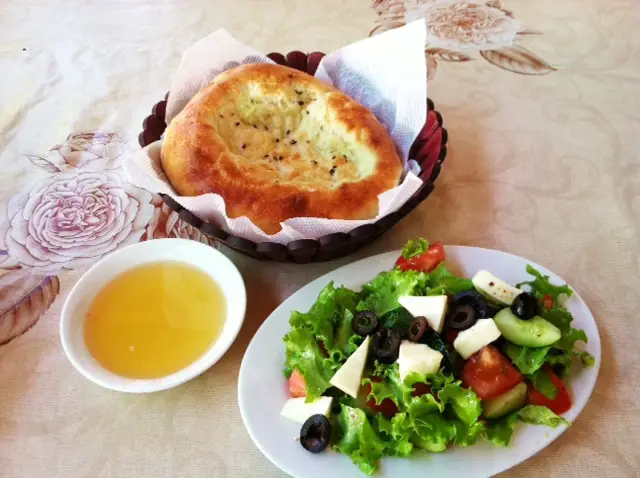
What to Eat in Bishkek: Trying Out the Local Cuisine on a Student Budget
One of the best ways to jump into a new culture is through the local food. The sheer act of sharing food experiences also gives you instant conversation starter material with locals. Central Asian cuisine, having developed largely from nomadic cultures, is often heavy on grains, pasta, dairy, and meat. We are sure that you […]

7 Ways Study Abroad is a Second Childhood
After settling in with a host family in Ukraine, I’ve looked back on my notes from my first couple of weeks abroad and come to a realization – in a lot of ways, Abroad-Olivia is a child, just a little bit bigger. I’ve compiled these notes to make a list of seven reasons why living […]
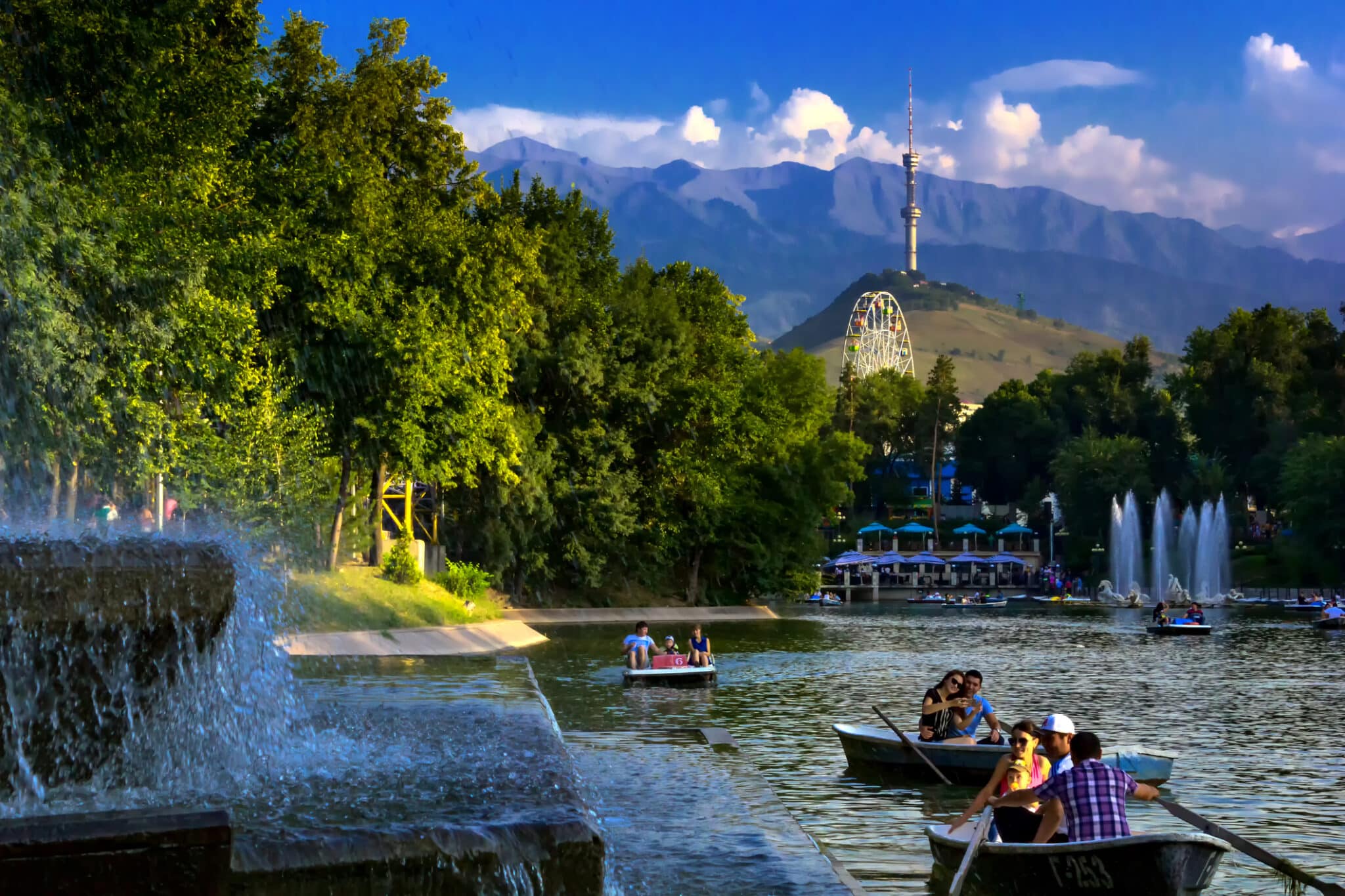
Travel to Almaty from Bishkek
At the end of my summer program in Bishkek, a friend of mine and I wanted a weekend getaway from Bishkek and decided to visit Kazakhstan’s largest city and former capital, Almaty, which is just over the border. A few other students had already gone and encouraged us to check it out. Almaty lies at […]

Top Ten Reasons Americans Should Visit Turkmenistan
This past week, I took a break from Kyrgyzstan and spent a few days traveling through Turkmenistan, visiting the cities of Ashgabad, Mary, Merv, Geok-Tepe, and Turkmenabad. This trip was arranged by The School of Russian and Asian Studies and The London School of Bishkek for participants of The Central Asian Studies study abroad program. […]
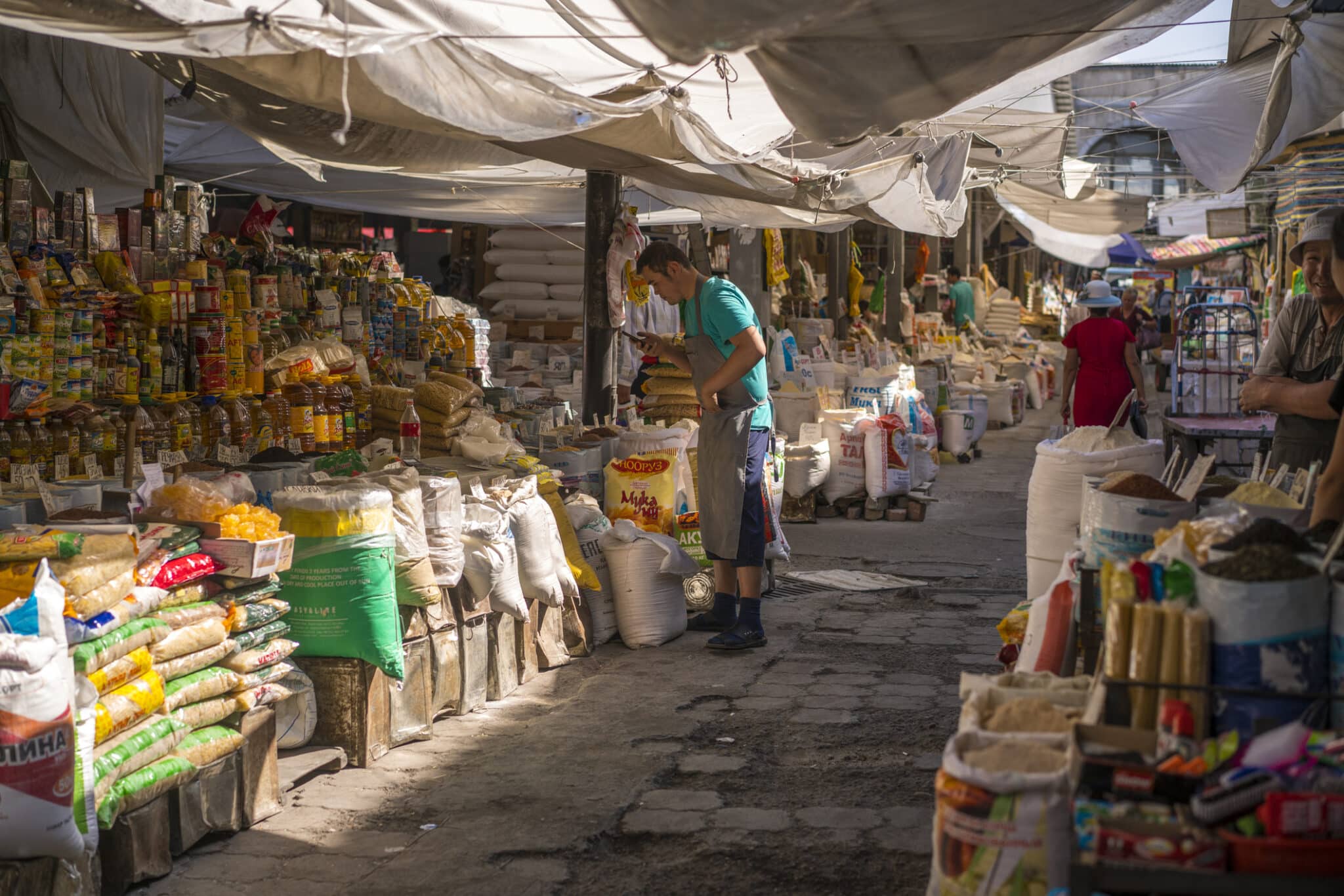
Bishkek Shopping: A Complete Guide
Bishkek brims with shopping outlets. From large shopping malls to tiny kiosks and its traditional bazaars, from antiques to the latest fashions, this guide hopes to introduce you to some of the best opportunities that students on SRAS programs in Bishkek have found! This resource is part of the much larger SRAS Guide to Living […]

